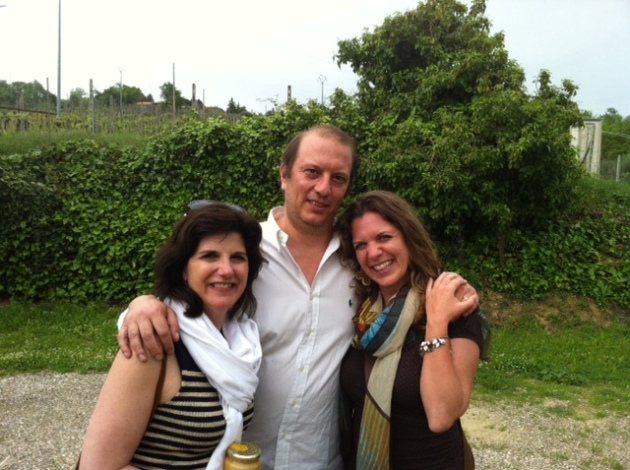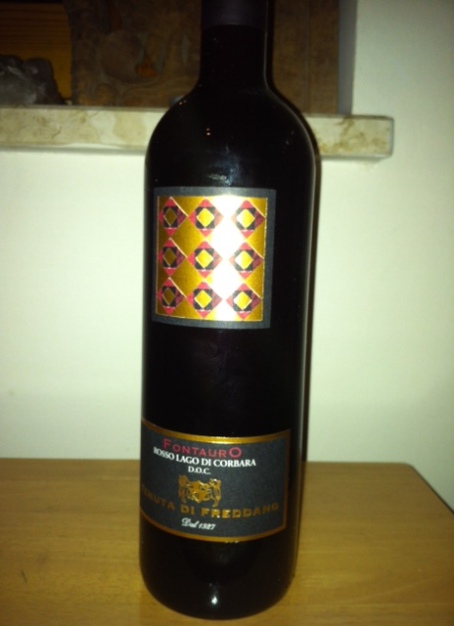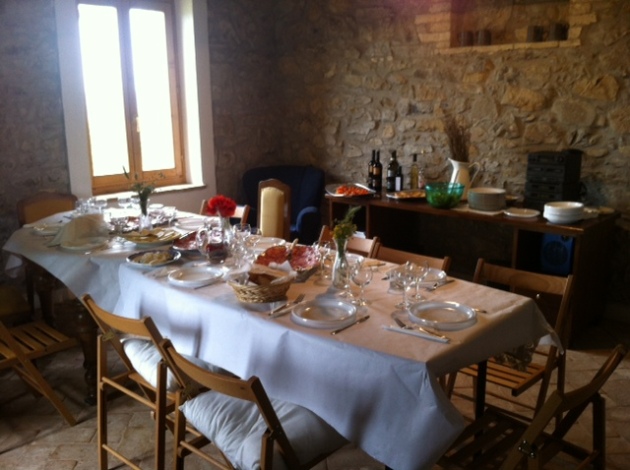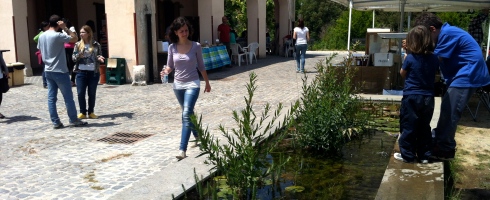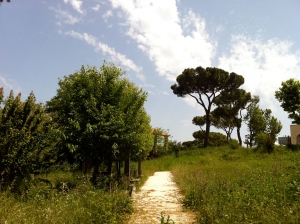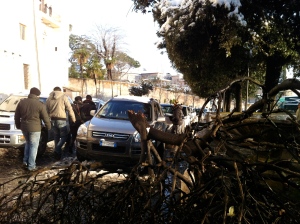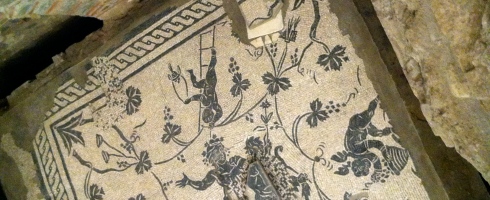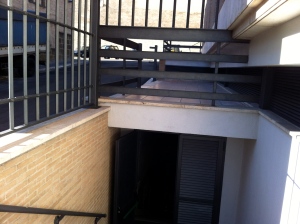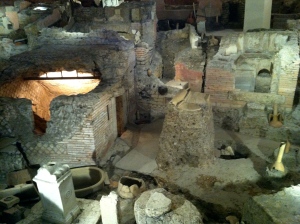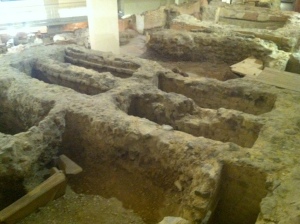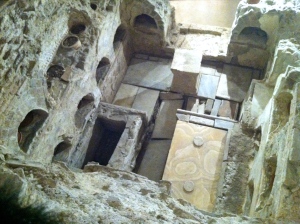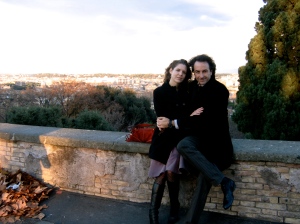I realize that with my travel schedule its been a while since I actually wrote a post regarding, you know, Rome. Today I braved the chilly temperatures and drizzle to visit the Basilica of San Clemente. San Clemente was one of the earliest bishops of Rome, and a contemporary of Saint Peter (and some say, Christ) in the first century AD; when being an open follower of Christianity predicted a short life and unpleasant death. Perhaps that was the inspiration for Christianity’s eventual persecution of pagans?
Just a few blocks away from the Colosseum, the Basilica of San Clemente is a fascinating reminder of the uniqueness of Rome’s layers of history and how many of its Christian traditions were layered upon Rome’s pagan roots. To explore this marvelous church is to walk back in time — and your starting point is 1100 AD.
If you are fortunate, you’ll enter through the square courtyard with its graceful fountain and covered walkways. Its simplicity belies the richly decorated 12th century church that sits at ground level. Entering from the courtyard, you are immediately enveloped by the intensity of the rich decor.

The upper level 12th Century interior (CC Rome-Roma)
Unfortunately, I don’t have any of my own photos as photography is forbidden, and only having been in Italy for a few months, I complied with the rules. This basilica is in remarkable condition despite being a thousand years old and each surface, from floor to ceiling, is adorned in a different style – from inlaid marble floors, to gorgeous frescos depicting the lives of saints and martyrs, to the luminescent mosaics about the main altar. I loved the frescos depicting the life and trials of Saint Catherine, who was persecuted by the Emperor Maxentius (who was a contemporary of, and defeated by Constantine – the first Christian Emperor of Rome).

Saint Catherine and an angel miraculously destroy the wheel of torture (CC Monkey Fur)
Like I said, layers and layers of history.
While wandering the 12th century basilica is fascinating enough, take a detour through the gift store, pay 5 euros for a ticket and descend through history.
The next level down brings you to the 4th century basilica. During one of the many sacks that Rome endured in the latter first millennium, this 4th century basilica was filled in and the current ground-level church was built upon its ruins in the 12th century. The 4th century Basilica is amazingly well displayed, full of lighting and descriptive plaques in English and Italian. The NYTimes describes it as “completely relit with discreet bronze lamps that shed light on once-hidden angles and cast haunting shadows. It was kind of like participating in a contemporary art installation (except the art was better).” Well done, Irish Dominicans.
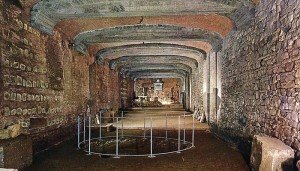
One level down in the 4th century basilica (CC newliturgicalmovement-org)
Wait, what?
According to Wikipedia:
Irish Dominicans have been the caretakers of San Clemente since 1667, when England outlawed the Irish Catholic Church and expelled the entire clergy. Pope Urban VIII gave them refuge at San Clemente, where they have remained, running a residence for priests studying and teaching in Rome. The Dominicans themselves conducted the excavations in the 1950s in collaboration with Italian archaeology students.
It gets better…descend one level more and you’ll realize that 2 stories under today’s surface you are now at the level of ancient, 1st Century Rome, before time and neglect covered its civilization in metres of mud. Hiding in the labyrinth of an ancient Roman patrician’s private villa are the remains of a Mithriac temple.
Let’s get to the patrician’s home first…it was apparently the villa of one of the first Roman senators who converted to Christianity; secretly holding meetings of the faithful in his home. As I mentioned, 1st century Rome was a dangerous time and place for Christians – the reign of the Emperor Nero who initiated imperially-sanctioned brutal persecutions of Christians and oversaw the crucifixion of St. Peter. Eventually a catastrophic fire destroyed this area of ancient Rome (attributed by many to Nero so he could build a golden palace). The 4th century basilica was build directly over the ruins of the villa, and by the way; nearby the Colesseum was built as a gift to the Roman people to help ease their loss off massive swathes of the city in the same fire. One of the more striking elements in this subterranean villa today is the sound of running water – in and before the first century AD, this villa was served by fresh spring water. It probably had radiant floor heating too; I regret to observe that Roman interior heating has not evolved much in the last 2,000 years.
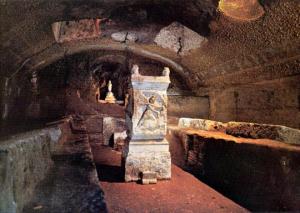
2 levels down in the cave of the Mithraic mysteries (CC Cueni.ch)
The Mithraic temple itself is very much a mystery, and its rituals and beliefs even at the height of its influence in the first century BC were only shared with its initiates. This temple was meant to resemble a ritual cave, and you can view the altar depicting the slaughter of a bull, and a tiny statue which seems to be Sol Invictus. Some historians link the cult of Mithras to Sol Invictus, the Unconquered Sun, whose birth was celebrated on December 25. Merry Christmas!
The vast array of breathtaking churches in Rome can be overwhelming, but although it’s a few blocks off the main tourist circuit, San Clemente is truly unique in its enormous span of history, as well as the the quality of its displays.
You can find it by walking past the Colosseum for a few blocks and turning right. Or you can follow this map.
41.919111
12.519400







